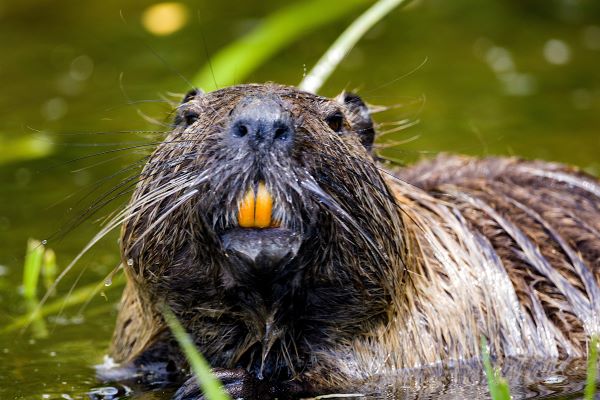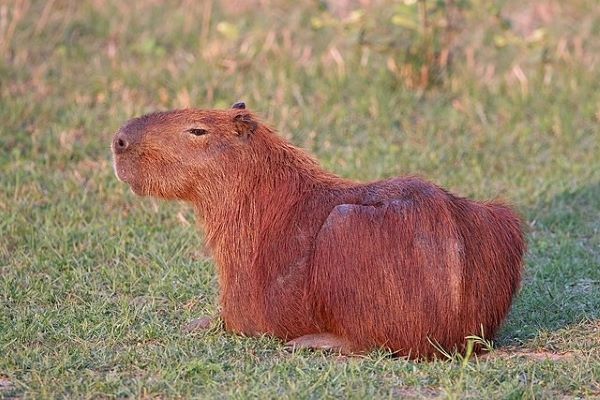
The word rodent probably conjures up images of squeaking rats or mice scurrying around your home. While these are abundant rodents, they’re far from the largest in the USA.
Rodents are an order of over 2,000 mammals with continuously growing teeth. The largest rodent in the USA is the capybara, but it has a tiny population and is non-native. But as far as native rodents, the largest native rodent is the beaver.
Keep reading this article to learn about capybara, beavers, and other rodents. Also, I’ve included a chart to help you understand the size difference between rodents in the USA. See my article: “How To Deal With Mouse Poop.“
What Are Rodents?
Rodents are part of the world’s largest order of mammals, Rodentia, with over 2,000 species. They inhabit every continent except Antarctica. The defining characteristic of rodents is their teeth, specifically their continuously growing, chisel-like incisor teeth.
These teeth have enamel on the front surface and dentin on the back, which makes them well-suited for gnawing, chewing, and cutting various foods, as well as for burrowing and other activities. To prevent their teeth from overgrowing, rodents must constantly gnaw on objects to wear them down.
Other features and traits of rodents are:
- Incisors: As mentioned, rodents have two pairs of sharp, continuously growing teeth in their upper and lower jaws.
- Omnivorous Diet: Many rodents are herbivores, primarily feeding on plants, seeds, nuts, fruits, and vegetation. However, some species may include insects and small animals in their diet.
- Nocturnal Behavior: Many rodents are primarily nocturnal, meaning they’re most active at night, while others are diurnal and active during the day.
- Burrowing Abilities: Many rodents are excellent burrowers and create complex underground tunnels for shelter and protection.
- Reproductive Rates: Rodents are known for their high birth rates. They typically have short gestation periods and produce litters of offspring, which helps their populations thrive.
Common examples of rodents include mice, rats, squirrels, chipmunks, guinea pigs, hamsters, and gerbils, among many others. While some people may view rodents as pests due to their tendency to infest homes or damage crops, they play critical ecological roles as seed dispersers, prey for predators, and in maintaining ecosystem balance.
Beavers Are The Largest Rodents Native to the USA
Adult beavers in the United States can weigh between 30 to 70 pounds (13.6 to 31.8 kilograms) and have a body length ranging from 2 to 3.5 feet (0.6 to 1.1 meters), excluding their distinctive flat, paddle-like tail. This size distinction sets them apart from other rodent species in the country, which are significantly smaller.
To help you visualize how beavers stack up to other American rodents, here’s a chart that lists the most common ones with their length and weight:
| Rodent | Length (inches) | Weight (pounds) | Native or Non-native | Where They Live |
|---|---|---|---|---|
| Capybara | 39-51 | 77-146 | Non-native | Florida |
| Beaver | 24-42 | 30-70 | Native | Nationwide, except HI |
| North American Porcupine | 24-36 | 8-39 | Native | Western, northern, and northeastern States |
| Nutria | 17-24 | 12-20 | Non-native | Southeastern states |
| Hoary Marmot | 20-30 | 8-12 | Native | Western mountain states, including AK |
| Prairie Dog | 12-16 | 2-4 | Native | Western and central states, particularly SD |
| Squirrel | 9-28 | 0.5-2 | Native | Nationwide |
| Gopher | 6-12 | 0.3-1.5 | Native | Various states, particularly in the West |
| Rat | 7-10 | 0.5-1 | Native and non-native species | Nationwide |
| Vole | 3-9 | 0.5-1 | Native | Various states, often in northern regions |
| Mole | 4-7 | 0.1-0.5 | Native | Nationwide |
| Mouse | 2-4 | 0.5-0.75 | Native and non-native species | Nationwide |
Beavers: Large Rodents With Large Importance to the American Ecosystem
Beavers are a keystone species in the USA’s environment. Their importance to the ecosystem can be seen through various habitat-altering contributions, such as:
- Water Management: Beavers are known for their dam-building activities, which create ponds and wetlands. These structures help regulate water flow by slowing water’s movement, reducing the risk of flooding during heavy rains, and ensuring a steady water supply during drier periods. This function is vital for maintaining healthy aquatic habitats and groundwater recharge.
- Habitat Creation: Beaver dams and lodges create new habitats for various species of plants and animals. The ponds formed behind their dams provide breeding and foraging grounds for amphibians, fish, waterfowl, and aquatic insects. The increased water availability also supports the growth of wetland vegetation.
- Increased Biodiversity: Beavers’ pond-building activities can lead to increased biodiversity. Wetlands are among the most biologically diverse ecosystems on the planet, hosting various plant and animal species. Beavers’ engineering efforts contribute to the richness of these ecosystems.
- Water Quality: By trapping sediments and pollutants in their ponds, beavers help improve water quality downstream. They act as natural filters, reducing the sediment, nutrients, and pollutants entering rivers and streams.
- Carbon Storage: Beaver ponds can act as carbon sinks, storing organic matter and carbon in the sediment at the bottom of the ponds. This can have implications for carbon cycling and help mitigate the effects of climate change.
- Erosion Control: Beaver dams can stabilize riverbanks and prevent soil erosion by trapping sediments and reducing the force of flowing water.
- Drought Resistance: In regions with seasonal water scarcity, beaver ponds help maintain water availability during dry periods, benefiting wildlife and human communities.
- Riparian Restoration: Beavers’ activities can enhance riverbank habitats by promoting the growth of vegetation along riverbanks, which in turn provides shade, habitat, and food for various species.
Largest Non-Native Rodent in the USA: Capybara

The capybara, while not native to the USA, has established populations in Florida. This introduction of capybaras to the state has made it the largest rodent in the USA. They’re the biggest rodent in the world.
Capybaras are native to South America, particularly Brazil, Venezuela, and Colombia. The population of capybaras in Florida can be attributed to escapes or releases from captivity, favorable climate conditions in parts of the state, and their ability to adapt to wetland habitats and grassy areas.
These large, herbivorous rodents have found suitable environments in Florida’s marshes, lakesides, and riversides, where they can graze on vegetation and find shelter. Thankfully, these rodents don’t seem to be outcompeting native wildlife, and there are only about 50 living in the state.
Largest Rat In The USA
Rats might be the first thing that comes to mind when you think of rodents. As we’ve seen, they’re not the largest rodent in the USA, but they can still get big.
There are several rat types in America, with the Gambian pouched rat taking the crown as the largest. This native of the African continent has only been spotted in the Florida Keys, with a small breeding population on Grassy Key.
They average about three pounds but can get as big as nine pounds. Their typical length ranges from 20 to 35 inches, with their tail making up as much as 18 inches.
Largest Native Rat In The USA
While the Gambian pouched rat is the biggest you can find in the USA, you’re unlikely to see one outside a small Floridian island. On the other hand, the bushy-tailed woodrat is the biggest native rat species, inhabiting a range from New Mexico to Alaska.
The bushy-tailed woodrat grows up to 18 inches long, half of which is its tail, and weighs only about one pound. You’ll likely see these rats in forests and rocky areas away from human settlements.
Most Common Rats in the USA
The Brown, or Norway, rat is the rat you’re most likely to see in the USA. They grow to about 16 inches long, making them smaller than bushy-tailed woodrats.
Brown rats are an invasive species that lives close to human populations. They prefer sewers, trash bins, and unused buildings for their homes.
If you have a problem with rats in your home, you can learn to trap them by reading my tips here.
Animal That Looks Like A Rat But Bigger
If you’ve seen an enormous, brown rat around, it might not be a rat at all; it could be a nutria. Indeed, nutria look like supercharged rats but have features that set them apart from their rodent cousins, including:
- Body Shape: Nutria have a more robust and elongated body than rats, which tend to have a sleeker and more compact appearance.
- Tail: Nutria have round, scaly, and shorter tails than rats in proportion to their body size.
- Facial Features: Nutria have a blunt, rounded nose, whereas rats typically have a pointed snout.
- Webbed Feet: Nutria have partially webbed hind feet adapted for their semi-aquatic lifestyle. Rats don’t have webbed feet.
- Lifestyle: Nutria tend to live in the wilderness and are semi-aquatic rodents, often found in wetlands, marshes, and aquatic habitats. Rats are more versatile and can inhabit varied environments, including urban areas.
An Invasive Rodent in the USA
Nutria is the fourth largest rodent in the USA, though they aren’t a native species. Their adaptability to wetland habitats has allowed them to establish populations in various parts of the United States, particularly in the southeastern states.
Unfortunately, nutria outcompete native species and damage critical ecosystems. Therefore, they’re an invasive species in many areas of the USA.
If you want to learn more about nutria, you can read the United States Department of Agriculture’s fact sheet here.